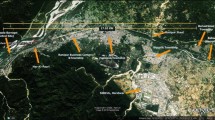Abstract
Untreated sewage of Hyderabad city is the key source of increasing pollution through discharge of sewage water into Phuleli canal causing contamination and hazards to the health of local people and irrigation system. This canal provides water to a population of more than two million of three major districts in lower Sindh along Akram Wah. Sewage water from Fullali canal was sampled from different station points and analyzed for pH, electrical conductivity (EC), total dissolved solid (TDS) residues, chlorides, hardness, alkalinity, dissolved oxygen (DO), and different cations like sodium (Na), calcium (Ca), magnesium (Mg), and potassium (K) to observe the effect of municipal discharge upon the quality of water used for irrigation purpose and also for drinking purpose. A significant number of samples showed elevated concentration of salts along the Phuleli canal which reached up to maximum values at three sampling stations. This canal water contaminated with pathogens and harmful toxic chemicals from effluents is hazardous to both the ecosystem and all life forms whose survival depends on it.
Access this chapter
Tax calculation will be finalised at checkout
Purchases are for personal use only
Similar content being viewed by others
References
American Public Health Association (1955) Standard methods for the examination of water sewage and industrial wastes, 10th edn. American Public Health Association, New York, p 59
APHA-AWWA-WEB (1992) Standard methods for the examination of water and wastewater, 18th edn. American Public Health Association, Washington, DC
Beg MAA (1977) The indus river basin and risk assessment of the irrigation system. International working seminar on environmental risk assessment in an international context, Tihanyi, Hungary, p 13
Milliman JD, Quraishee GS, Beg MAA (1984) Sediment discharge from the Indus River to the ocean: past, present and future. In: Marine Geology and Oceanography of Arabian Sea and Coastal Pakistan, (ed. by B. U. Haq & J. D. Milliman), Van Nostrand Reinhold, New York, pp. 66–70
Monenco (Montreal Engineering Company) (1984) Hydroelectric inventory ranking and feasibility studies for Pakistan. CIDA Project 714/00603. WAPDA, Lahore. River to the ocean: past, present and future. In: Haq BU, Milliman JD (eds) Marine geology and oceanography of Arabian Sea and coastal Pakistan. Van Nostrand Reinhold, New York, pp 5–70
Ferguson RI (1984) Sediment load of the Hunza River. In: Miller KJ (ed) The international karakoram project. Cambridge University Press, Cambridge, pp 580–598
Searle MP (1991) Geology and tectonics of the karakoram mountains. Wiley, New York
Collins DN, Hasnain SI (1995) Runoff and sediment transport from glacierized basins at the Himalayan scale. In: Proceedings of boulder symposium, July 1995, IAHS Publ. No. 226, pp 17–25
Meadows A, Meadows PS (eds) (1999) The indus river: biodiversity, resources, humankind. Oxford University Press, Karachi
Shanan L (1992) Planning and management of irrigation systems in developing countries. Agr Water Manag 22(1–2):1–234
Ansari IA, Dewani VK, Khuhawar MY (1999) Evaluation of metal contents in Phuleli canal and Hyderabad city sewage by flame atomic absorption spectrometer. J Chem Soc (Pak) 21:359–368
Dewani VK, Ansari IA, Khuhawar MY (2002) Quantitative assessment of nitrogen and phosphorus contents in Hyderabad City sewage and Fuleli canal water. Pak Counc Sci Ind Res 45(5):295–301
Mastoi GM (2003) Doctoral thesis, University of Sindh, Jamshoro, Sindh, pp 48–70
Dewani VK, Ansari IA, Khuhawar MY (2003) Effect of residues and chemical oxygen demand in Hyderabad city sewage added on the Fuleli canal water contents. J Chem Soc (Pak) 25:165–171, Part 2
Wattoo MHS, Wattoo FH, Kazi TG, Tirmizi SA, Bhanger MI, Mahar RB, Iqbal J (2004) Quality characterization of Phuleli canal water for irrigation purposes. Nucleus 41(1–4):69–75
World Health Organisation (1993) Guidelines for drinking water quality, vol 1, 2nd edn, Recommendations. World Health Organization, Geneva
World Health Organisation (1996) Guidelines for drinking water quality, vol 2, 2nd edn, Health criteria and other supporting information. World Health Organization, Geneva
Author information
Authors and Affiliations
Corresponding author
Editor information
Editors and Affiliations
Rights and permissions
Copyright information
© 2012 Springer-Verlag/Wien
About this chapter
Cite this chapter
Qureshi, S., Mastoi, G.M., Ghanghro, A.B., Mastoi, A.W. (2012). Impact of Sewage Water on Quality of Fullali Canal Water, Hyderabad, Sindh, Pakistan. In: Uqaili, M., Harijan, K. (eds) Energy, Environment and Sustainable Development. Springer, Vienna. https://doi.org/10.1007/978-3-7091-0109-4_19
Download citation
DOI: https://doi.org/10.1007/978-3-7091-0109-4_19
Published:
Publisher Name: Springer, Vienna
Print ISBN: 978-3-7091-0108-7
Online ISBN: 978-3-7091-0109-4
eBook Packages: Earth and Environmental ScienceEarth and Environmental Science (R0)




